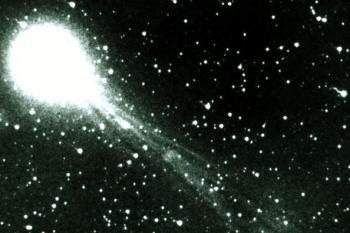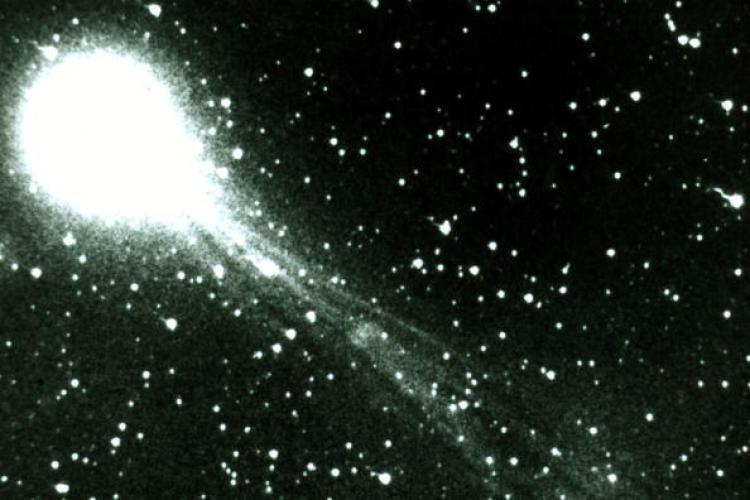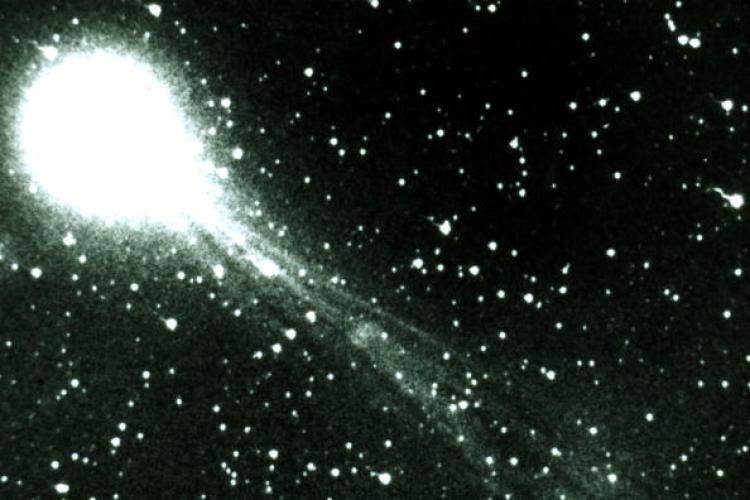Sky watchers are looking east towards the moon to view the Eta Aquarid meteor shower which reaches its peak on Thursday morning, Eastern Time. Visibility may be reduced a bit due to light from the last quarter moon. Media attention is being drawn to the annual shower which, according to a NASA official on Nasa.gov, has a special claim to fame: the Eta Aquarids are pieces of ice and dust that separated from Halley’s Comet, astronomy’s best-known icy snowball.
Specifically, these tiny, sand-grain sized meteors are generated every 76 years, after Halley’s Comet comes close enough to the sun for approximately six meters of ice and rock to be evaporated from the comet’s nucleus. These particles then spread evenly in the wake of the comet. Scientists agree that almost if not every meteor you see in the Eta Aquarid shower will have once been a part of Halley’s Comet.
The fact that pieces of Halley’s Comet are visible in the annual Eta Aquarid meteor shower add to the attention the shower draws each year. The famous comet bears the name of Sir Edmund Halley, who first predicted the period of the comet. Reports of a phenomenon now believed to have been the comet date back to as early as 240 BC. As it made one of its passes near earth in 1066 AD, a few months before the Battle of Hastings, the comet attracted a great deal of attention and was considered a portent of change. It has drawn attention on many of its trips past the earth.
Halley’s Comet still brings a thrill for sky watchers, as do fragments of the comet in the two annual meteor showers from the comet’s debris. Earth’s orbit crosses that of Halley’s Comet twice a year, in the spring and the fall. Because the orbit of Halley’s Comet and Earth’s orbit move in opposite directions, those tiny particles and Earth approach each other at high speed, with NASA estimating that star gazers will be viewing meteors that travel at nearly 148,000 mph (238,000 km/h). Astronomy.com reported that this is the second-fastest meteor show of the year.
Earth’s orbit and that of our moon are naturally crossing the trail of particles at about the same time. Without the benefit of an atmosphere, the moon will come into direct contact with the particles. NASA’s website reports that a meteor fragment the size of a grapefruit impacting the moon could cause a brief flash capable of being viewed through binoculars with the naked eye. But both NASA’s site and astronomy.com reassure that not only are the Eta Aquarids quite small, but they are due to completely burn up in the earth’s atmosphere.
If you are delving into the Latin name of these reportedly tiny fragments, you might wonder – if these are all pieces of Halley’s Comet, why are they named for the constellation Aquarius? In the fall, we will encounter them again, and at that time they will be named for the constellation Orion. Meteor showers are named for the constellation that contains the point they appear to radiate from, or the radiant. The radiant of the Eta Aquarids is the star Eta Aquarius, in the constellation Aquarius.
This year, the moon will be located 20 degrees to the right and slightly above the shower’s radiant. This will obscure the show with moonlight, however, it will make it simple for amateur astronomers to pinpoint the shower. Additionally, in the northern hemisphere, because the constellation Aquarius is low on the horizon, only the brightest and slowest meteors might be noticeable. Sky watchers in the southern hemisphere should have more of a show. According to Seasky.org’s astronomy resource site, the best viewing is in the eastern sky after midnight between May 4-7.
For those wanting to catch a glimpse of Halley’s Comet, you have time to save for a better telescope to complement your sky watching, as the comet is not due to be visible from earth again until 2061.
Specifically, these tiny, sand-grain sized meteors are generated every 76 years, after Halley’s Comet comes close enough to the sun for approximately six meters of ice and rock to be evaporated from the comet’s nucleus. These particles then spread evenly in the wake of the comet. Scientists agree that almost if not every meteor you see in the Eta Aquarid shower will have once been a part of Halley’s Comet.
The fact that pieces of Halley’s Comet are visible in the annual Eta Aquarid meteor shower add to the attention the shower draws each year. The famous comet bears the name of Sir Edmund Halley, who first predicted the period of the comet. Reports of a phenomenon now believed to have been the comet date back to as early as 240 BC. As it made one of its passes near earth in 1066 AD, a few months before the Battle of Hastings, the comet attracted a great deal of attention and was considered a portent of change. It has drawn attention on many of its trips past the earth.
Halley’s Comet still brings a thrill for sky watchers, as do fragments of the comet in the two annual meteor showers from the comet’s debris. Earth’s orbit crosses that of Halley’s Comet twice a year, in the spring and the fall. Because the orbit of Halley’s Comet and Earth’s orbit move in opposite directions, those tiny particles and Earth approach each other at high speed, with NASA estimating that star gazers will be viewing meteors that travel at nearly 148,000 mph (238,000 km/h). Astronomy.com reported that this is the second-fastest meteor show of the year.
Earth’s orbit and that of our moon are naturally crossing the trail of particles at about the same time. Without the benefit of an atmosphere, the moon will come into direct contact with the particles. NASA’s website reports that a meteor fragment the size of a grapefruit impacting the moon could cause a brief flash capable of being viewed through binoculars with the naked eye. But both NASA’s site and astronomy.com reassure that not only are the Eta Aquarids quite small, but they are due to completely burn up in the earth’s atmosphere.
If you are delving into the Latin name of these reportedly tiny fragments, you might wonder – if these are all pieces of Halley’s Comet, why are they named for the constellation Aquarius? In the fall, we will encounter them again, and at that time they will be named for the constellation Orion. Meteor showers are named for the constellation that contains the point they appear to radiate from, or the radiant. The radiant of the Eta Aquarids is the star Eta Aquarius, in the constellation Aquarius.
This year, the moon will be located 20 degrees to the right and slightly above the shower’s radiant. This will obscure the show with moonlight, however, it will make it simple for amateur astronomers to pinpoint the shower. Additionally, in the northern hemisphere, because the constellation Aquarius is low on the horizon, only the brightest and slowest meteors might be noticeable. Sky watchers in the southern hemisphere should have more of a show. According to Seasky.org’s astronomy resource site, the best viewing is in the eastern sky after midnight between May 4-7.
For those wanting to catch a glimpse of Halley’s Comet, you have time to save for a better telescope to complement your sky watching, as the comet is not due to be visible from earth again until 2061.






